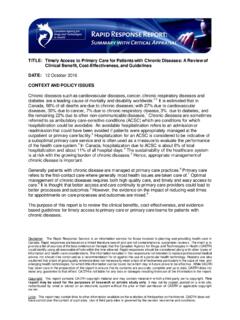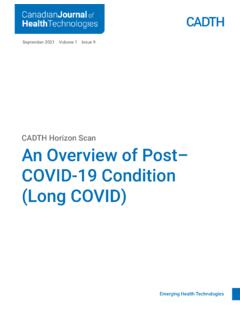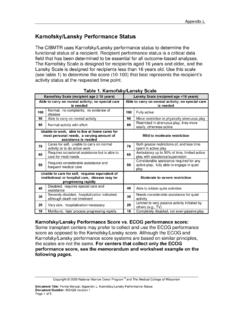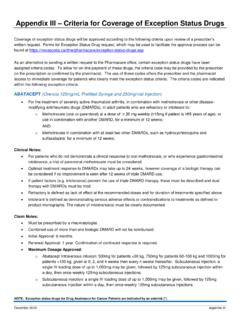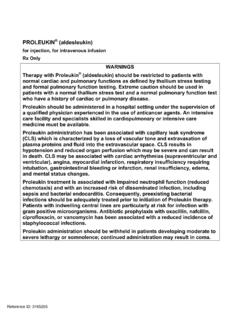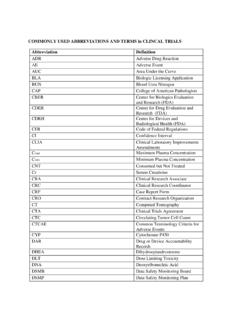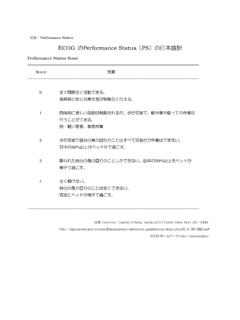Transcription of EVIDENCE IN BRIEF
1 Final Recommendation for Ruxolitinib (Jakavi) for Myelofibrosis pERC Meeting: October 18, 2012; pERC Reconsideration Meeting: December 20, 2012 2013 pCODR | PAN-CANADIAN ONCOLOGY DRUG REVIEW 3 noted that there are case reports of a rebound effect upon discontinuation of ruxolitinib (Tefferi 2012), although this was not observed in either the COMFORT I or COMFORT II studies. Therefore, pERC considered it important that when considering discontinuation of treatment, the ruxolitinib dose be appropriately tapered. pERC reviewed patient advocacy group input and noted that the detailed descriptions of patients experiences with ruxolitinib and the high quality of the input was very useful in determining if ruxolitinib aligned with patient values.
2 PERC noted that patient input indicated that there are few treatments available for patients with myelofibrosis and that there is a need for effective therapies. pERC also noted that patients with direct experience with ruxolitinib had improvements in quality of life symptoms such as fatigue, and these improvements enabled them to return to normal activities. These benefits from treatment were highly valued by patients. These patients also noted that the side effects experienced with ruxolitinib were tolerable, when considering the benefits of symptom control and improved quality of life.
3 Therefore, pERC considered that ruxolitinib aligned with patient values. pERC also considered factors affecting the feasibility of implementing a recommendation for ruxolitinib. The Committee noted that myelofibrosis is an uncommon condition; therefore the burden of illness is likely small for the incident population. However, because there are currently only marginally effective treatments, there will be a population of patients in the community who will require treatment with ruxolitinib. The size of this patient population is unknown but it could be significant.
4 PERC also noted that to enhance feasibility and manage monthly drug costs associated with ruxolitinib s use in actual practice, provinces may need to consider factors such as clear monitoring plans to evaluate patients for response, and the budget impact of a number of issues relating to dosing: ruxolitinib being priced per tablet rather than per milligram, the variety of dosing schedules that may be used, drug wastage around dose adjustments and the need for dose tapering upon discontinuation of therapy. pERC deliberated on the cost-effectiveness of ruxolitinib and agreed with the Economic and Clinical Guidance Panels that a time horizon of two to three years was most appropriate for use in the submitted economic model.
5 PERC concluded that the EGP s estimated range for incremental cost-effectiveness ratios was likely more realistic than the Submitter s estimates and ruxolitinib could not be considered cost-effective. In discussing the cost-effectiveness estimates, pERC noted that despite the important improvements in symptoms and quality of life that were observed in COMFORT I and COMFORT II studies and described in patient advocacy group input, the incremental cost-effectiveness ratio was quite sensitive to small incremental changes in quality-adjusted life years. This was primarily due to the high incremental treatment costs associated with ruxolitinib.
6 PERC also discussed that there was uncertainty in the estimates of incremental cost due to per tablet pricing of ruxolitinib and possible dose adjustments that may require multiple tablets; the need for ongoing monitoring to ensure patients are responding to ruxolitinib; the indefinite duration of treatment for patients who continue to respond to ruxolitinib; and dose tapering that is required upon discontinuation of ruxolitinib. Therefore, pERC considered that there was considerable uncertainty in the cost-effectiveness estimates provided for ruxolitinib.
7 EVIDENCE IN BRIEF pERC deliberated upon: a pCODR systematic review other literature in the Clinical Guidance Report providing clinical context an evaluation of the manufacturer s economic model and budget impact analysis guidance from pCODR clinical and economic review panels input from two patient advocacy groups (The Chronic Myelogenous Leukemia (CML) Society of Canada and the Canadian Myeloproliferative Neoplasms (MPN) Network) input from pCODR s Provincial Advisory Group. Feedback on the pERC Initial Recommendation was also provided by: pCODR s Provincial Advisory Group.
8 Two patient advocacy groups (The CML Society of Canada and the Canadian MPN Network) the Submitter (Novartis Pharmaceuticals Canada Inc.) Final Recommendation for Ruxolitinib (Jakavi) for Myelofibrosis pERC Meeting: October 18, 2012; pERC Reconsideration Meeting: December 20, 2012 2013 pCODR | PAN-CANADIAN ONCOLOGY DRUG REVIEW 4 The pERC Initial Recommendation was to recommend funding ruxolitinib conditional on the cost-effectiveness of ruxolitinib being improved to an acceptable level. Ruxolitinib should be funded in patients with intermediate-2 to high risk symptomatic myel ofibrosis, ecog performance status <3 who are previously untreated or refractory to other treatment.
9 Feedback on the pERC Initial Recommendation indicated that the manufacturer and one patient advocacy group (The CML Society of Canada) agreed in part with the initial recommendation; pCODR s Provincial Advisory Group and one patient advocacy group (The Canadian MPN Network) agreed with the initial recommendation. OVERALL CLINICAL BENEFIT pCODR review scope The pCODR review evaluated the efficacy and safety of ruxolitinib on patient outcomes compared with standard therapies, placebo, or best supportive care in the treatment of patients with splenomegaly and/or its associated symptoms in adult patients with primary myelofibrosis (also known as chronic idiopathic myelofibrosis), post-polycythemia vera myelofibrosis, or post-essential thrombocythemia myelofibrosis.
10 Studies included The pCODR systematic review included two randomized controlled trials (RCTs) that evaluated ruxolitinib (15mg or 20 mg BID, dosed according to platelet counts), COMFORT I (Verstovsek 2012) and COMFORT II (Harrison 2012): COMFORT I was a double-blind RCT that compared ruxolitinib to placebo; cross-over upon progression could occur before the measurement of the primary endpoint at 24 weeks. COMFORT II was an open-label RCT that compared ruxolitinib to best available therapy; cross-over upon progression could occur either at 24 weeks or 48 weeks.


